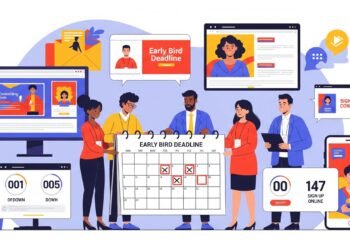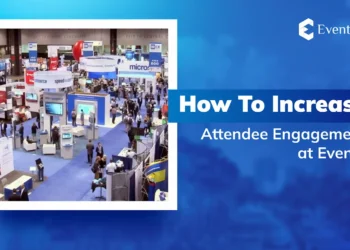The Ultimate Guide to Event Sponsorship Success
Event sponsorship plays a defining role in turning an ordinary event into a powerhouse experience that benefits organizers, attendees, and brands alike. The right sponsors bring more than just funding. They bring credibility, marketing reach, audience trust, and added energy to the experience. For attendees, it could be a sponsored workshop they loved, a product sample they took home, or even a conversation at a branded booth that led to something bigger.
For event organizers, the benefits range from media exposure to attendee satisfaction to long-term partnerships that grow from one event to many. But attracting event sponsors is never sending off a few outreach emails. Brands today are selective. They’re approached constantly, and they’re careful about where they invest. Getting their attention and keeping it takes more than just a well-designed logo placement package. It requires a thoughtful mix of timing, alignment, storytelling, and value delivery.
That’s where strategy comes in. And creativity. And understanding what brands are looking for when they choose to put their name and budget behind an event. In this blog, we’ll unpack powerful ways to get sponsors for events, give you insider tips for securing sponsors, and walk you through what today’s sponsors are looking for.
Why Event Sponsorship Is No Longer Just a Logo
Sponsorship in the current event has changed significantly. What once revolved around simple logo placements and banner exposure has evolved into something far more dynamic and intentional. Event sponsorship is no longer about visibility alone; it’s about meaningful engagement, audience connection, and shared goals.
Brands nowadays are not looking to just be noticed but want to be part of the experience. They’re seeking opportunities that allow them to interact with attendees, tell their stories, and deliver measurable value. That means offering more than just a logo on collateral. It means giving sponsors the chance to participate, connect, and leave an impression.
So, before creating any event sponsorship proposal, it’s important to understand what a sponsor truly needs. Their focus is often on outcomes: increased brand awareness, high-quality leads, thought leadership, or alignment with a particular community or cause. When you’re considering how to get event sponsorship, start by asking: What does success look like for them?
This shift, from transactional exchanges to strategic partnerships, is at the core of every successful event sponsorship strategy. And it’s this mindset that allows event organizers to build event sponsorship opportunities that are not only attractive but sustainable across future events.
Effective Ways to Attract More Sponsors to Your Events
Event sponsorship is about forging strategic partnerships that elevate the experience for attendees while delivering strong brand exposure and ROI to sponsors. Below are some tried-and-tested tactics and some lesser-known, but highly effective, event sponsorship strategies that help you seal the deal and build lasting sponsor relationships.
1. Start With a Solid Sponsorship Mindset
Before you draft an event sponsorship proposal, take a step back and assess your mindset. Sponsorship is a transaction so you need to think beyond your needs and focus on the sponsor’s benefits. What do they want from the partnership?
Be it brand exposure, lead generation, community engagement, or product sampling, align your event goals with theirs. That’s the starting point of any successful event sponsorship.
2. Define Your Audience in Crystal-Clear Detail
Sponsors care most about who they’re reaching. When outlining how to get event sponsorship, always lead with data.
Use your past events or registration analytics to show:
- Demographics (age, gender, location)
- Industry and job roles
- Decision-making power
- Budget ranges
- Interests and behaviors
This kind of insight builds confidence. It tells potential event sponsors that their investment isn’t a gamble, it’s strategic.
3. Build a Stellar Sponsorship Deck
Your sponsorship proposal for events must look polished and persuasive. Make it concise but impactful. Focus on outcomes, not features. Some of the must-have elements include:
- Event overview and purpose
- Audience demographics and data
- Marketing reach (email, social, media partners)
- Branding placements and sponsorship levels
- Customized event sponsorship perks and incentives
- Creative sponsorship ideas for events
- Case studies or sponsor testimonials
- Clear call to action and contact info
Make it visual. Infographics, icons, and charts go a long way in keeping sponsors engaged.
4. Segment Your Sponsor Targets
Not every brand fits every event. Effective sponsor outreach begins with segmentation. Build a list of:
- Local businesses
- Industry-aligned brands
- Lifestyle or experiential companies
- Tech or platform sponsors
- Government or NGO stakeholders (for civic events)
This segmentation will help personalize your pitch, increase relevance, and improve your chances of attracting event sponsors.
5. Customize Proposals Based on Sponsor Goals
When exploring how to get sponsors for a corporate event, don’t use a standard template. Understand each brand’s objectives and customize your offerings. For example:
- A bank might want booth visibility and lead forms.
- A fitness brand might prefer social activations or swag bag placement.
- A SaaS company may want speaking opportunities and thought leadership.
Tailored sponsorship proposals demonstrate that you value the sponsor’s success as much as your own.
6. Offer Tiered Sponsorship Levels and Add Flexibility
Create three to four event sponsorship levels (Platinum, Gold, Silver, Bronze), each with increasing sponsor benefits. But go beyond the standard tiers—offer customizable add-ons.
Here are bonus packages to consider:
- Sponsored email campaigns
- Branded attendee badges
- Sponsored lounges or cafés
- Sponsored mobile app features
- Event Wi-Fi naming rights
Flexibility makes you easier to work with, and easier to say yes to.
7. Reach Out Early and Build Real Relationships
Reach out to event sponsors early in planning. Waiting until a month before the event is a recipe for rejection. Brands plan budgets and marketing calendars months in advance.
Initial outreach should be soft. Start conversations, not sales pitches.
Message framework:
- Mention a relevant connection or common goal
- Explain briefly why the event aligns with their brand
- Offer to share a customized sponsorship proposal
- Ask for a 15-minute call to explore synergies
Relationship-first outreach builds trust and lays the groundwork for a long-term corporate sponsorship.
8. Use Storytelling to Sell the Experience
Don’t just list bullet points in your pitch. Use storytelling.
Explain in detail what sponsorship feels like. Describe how attendees interact with sponsor booths. Show how branded lounges become hubs of engagement. Share quotes from attendees about their favorite sponsor activations.
People remember stories, not stats. And that applies to sponsors, too.
9. Create Unique and Interactive Sponsor Activations
Static banners are dead. Modern sponsors want interactivity and shareability.
Some popular interactive event sponsor activation ideas:
- Augmented reality photo booths
- Sponsored trivia games with real-time leaderboards
- Gamified scavenger hunts
- Branded hydration stations or massage chairs
- “Spin the wheel” contests at booths
These creative sponsorship ideas for events turn attendees into participants and make the sponsor’s presence unforgettable.
10. Include Digital-Only Sponsorship Opportunities
Even in-person events have digital touchpoints. For event sponsors with smaller budgets or remote engagement goals, offer:
- Sponsored social media shoutouts
- Newsletter ad placements
- Logo on event website
- Branded Zoom backgrounds
- Digital swag bags or coupons
These are excellent ways to get sponsors for events that may not have a large physical footprint.
11. Emphasize Pre-Event and Post-Event Exposure
Many organizers focus only on event-day visibility. Big mistake.
Sponsors want long-term exposure. Promote them before and after the event through:
- Email blasts
- Speaker announcements
- Recap blogs
- Photo galleries
- Highlight reels
This 360-degree presence gives more value and justifies a higher event sponsorship level.
12. Partner With Media and Influencers
Want to supercharge your event marketing and attract premium sponsors?
Team up with local media outlets, LinkedIn influencers, or niche bloggers in your industry. Offer them VIP access in exchange for coverage. Then include their projected reach in your sponsorship proposal for events. This creates a halo effect that attracts brands hungry for exposure.
13. Use Attendee Data to Win Sponsors Over
If you’ve hosted previous events, use your data to show impact:
- Conversion rates from sponsor booths
- QR code scans
- App click-through rates
- Lead volumes delivered
- Attendee satisfaction scores
This builds credibility and helps brands see real value. It’s a winning move when figuring out how to get sponsors for a conference or how to find sponsors for a trade show.
14. Promote Sponsor Perks Loudly
Sponsors want attendees to know they’re involved. Highlight event sponsorship perks and incentives loudly through:
- Push notifications on event day
- Social media countdowns featuring sponsors
- Shout-outs in the opening and closing ceremonies
- Sponsored merchandise giveaways
The more visibility they get, the more likely they’ll renew.
15. Create a Sponsor Lounge or VIP Experience
High-level event sponsors expect exclusivity. Consider creating a sponsor-only lounge with:
- Networking cocktails
- Product displays
- Premium seating areas
- Charging stations
- Live streams of main sessions
This exclusive treatment adds perceived value and attracts elite brands.
16. Use Peer Influence and Showcase Other Sponsors
One underrated event sponsorship strategy: Use your current sponsors to attract others.
Seeing reputable brands already involved creates FOMO. It validates your event and gives new prospects confidence in your audience.
Feature sponsor logos prominently in decks, on social, and in your event page banner.
17. Host a Sponsor Welcome Call
Before the event, organize a virtual onboarding call. Introduce sponsors to each other, walk them through the schedule, and offer tips for maximizing ROI.
This adds a human touch and shows that you’re serious about partnership and not just promotion.
18. Offer Metrics and Transparent Reporting
After the event, share a sponsor impact report that includes:
- Brand impressions
- Booth visits
- Content engagement
- Lead quality breakdown
- Social shares and hashtags
Sponsors are more likely to return when they can clearly see the outcomes of their investment.
19. Follow Up with a Retention Strategy
Don’t wait until next year to talk again. Add sponsors to your year-round communication. Share relevant content, seasonal updates, and early-bird packages.
Offer loyalty pricing or perks for early commitment. This builds long-term relationships and reduces sponsor churn.
20. Learn From What Doesn’t Work
You must understand that the event sponsorship idea will not land every time. Some sponsors may ghost you, others may not renew. That’s okay.
Always debrief internally and with sponsors. Ask:
- What part of the pitch didn’t connect?
- What felt too generic?
- Were the benefits unclear?
- Was engagement lower than expected?
Every no brings you closer to a better yes.
Final Thoughts
Mastering event sponsorship is both an art and a science. You need compelling storytelling, data-backed strategies, and the creativity to offer value no one else can. By applying these tips to attract sponsors for your event, building thoughtful sponsorship proposals, and personalizing every pitch, you create something more than a deal; you create a partnership.
So, from brainstorming on how to get sponsors for a conference, how to get sponsors for a corporate event, or exploring new ways to get sponsors for events, the key is to stay focused on value, clarity, and authenticity. When done right, event sponsorship becomes a long-term growth engine for you and your partners alike.


















